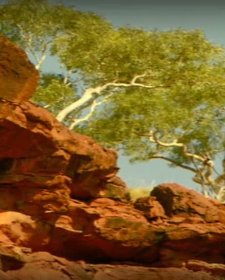Temporary road closures will block vehicle access to our building on Sunday 13 April until 3:00pm.
Herbert Vere Evatt (1894–1965) was a Labor politician, judge, historian and statesman. In 1930, aged 36, Evatt became the youngest judge ever appointed to the High Court of Australia. Elected to Federal Parliament in 1940, he held the seat of Barton for 18 years. From 1941 to 1949 he was Attorney-General and Minister for External Affairs, and during this period he also served as President of the General Assembly of the United Nations. In 1951, he became Leader of the Opposition. In 1949, the Australian Security Intelligence Organisation was established, and soon thousands of supposed communists were threatened with jail in the event of a war. When Prime Minister Menzies attempted to outlaw the Communist Party in Australia, Evatt led the effort to defeat the proposal. A referendum saw the Party’s legitimacy confirmed. Evatt led the Labor Party until 1960.
Arrernte artist Albert Namatjira (1902–1959) is one of Australia's most celebrated and important artists. He is recognised as the first person to link Aboriginal art and culture with European painting techniques. Born at Hermannsburg (Ntaria) near Alice Springs, Namatjira had been making art for much of his life before becoming interested in watercolour painting in the 1930s. Exhibiting from 1938 to acclaim and working prolifically, demand for his paintings increased during the 1940s. Though famous by the 1950s, First Nations people were not recognised in the Australian constitution at this time and faced widespread prejudice and inequality. Namatjira met Queen Elizabeth II in Canberra in 1954, and was the first Aboriginal person to receive citizenship in 1957, but restrictions on his family and his community remained engrained and complex, ultimately leading to his death in 1959. His distinctive style, though seemingly taking on the appearance of Western landscape traditions is rooted in deep ancestral connection and knowledge of the lands spanning his father’s country around the MacDonnell Ranges and his mother’s country in the region of Palm Valley in Central Australia. The Gamatj clan leader Yunupingu AM leader has explained that in his work Namatjira was 'demonstrating to the rest of the world the living title held by his people to the lands they had been on for thousands of years'.
Dame Mary Gilmore DBE (1865–1962), poet, journalist and social reformer, was born near Goulburn and had an itinerant childhood as her father moved the family around New South Wales for work. At sixteen she began working as a teacher in Wagga Wagga and other country towns before being transferred to Neutral Bay in 1890. She met Henry Lawson around that time and they had a close relationship until 1895, when she retired from teaching and moved to Paraguay, South America with followers of the utopian socialist William Lane. There she married William Gilmore, a shearer, and had a son, before settling in Casterton, Victoria. Gilmore was the first female member of the Australian Workers' Union, and from 1908 to 1931 championed a variety of social causes as editor of the women's page of the Australian Worker, including votes for women, children's welfare, aged and invalid pensions, and better treatment for Aboriginal people and returning servicemen. She also wrote for the Bulletin and the Sydney Morning Herald. Gilmore published the first of many collections of poetry in 1910 and she and her son moved back to Sydney two years later. In 1930 she published The Wild Swan, a book of verse decrying white settlers' ravaging of the land and indifference to Aboriginal culture; Under the Wilgas (1932) and subsequent works expanded on this theme. Between 1891 and 1961 at least thirteen portraits were made of Gilmore by various artists, an indication of her importance as a feminist and social crusader. She was made a Dame of the British Empire in 1937 in recognition of her contribution to Australian life and literature. Her State funeral in Sydney was the first for an Australian writer since that of her friend – possibly, briefly, her boyfriend – Lawson, 40 years earlier. She is featured on the reverse of the Australian $10 note and the Canberra suburb Gilmore is named after her.
Collection: National Portrait Gallery
Purchased with funds provided by Marilyn Darling AC 2008
Herbert Vere Evatt (age 56 in 1950)
Albert Namatjira (age 48 in 1950)
Dame Mary Gilmore DBE (age 85 in 1950)



On one level The Companion talks about the most famous and frontline Australians, but on another it tells us about ourselves.



21 December 2020
In their own words lead researcher Louise Maher on the novel project that lets the Gallery’s portraits speak for themselves.



The art and landscape of Albert Namatjira.